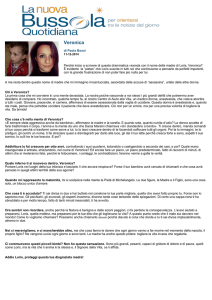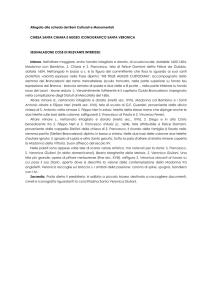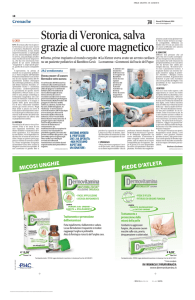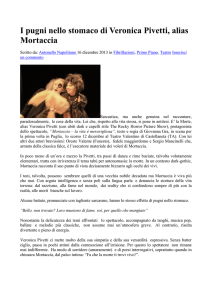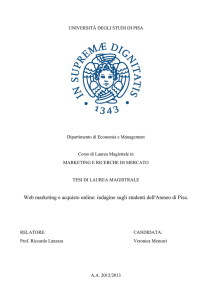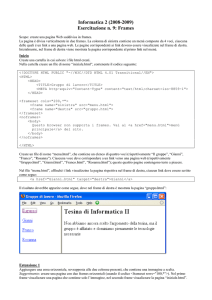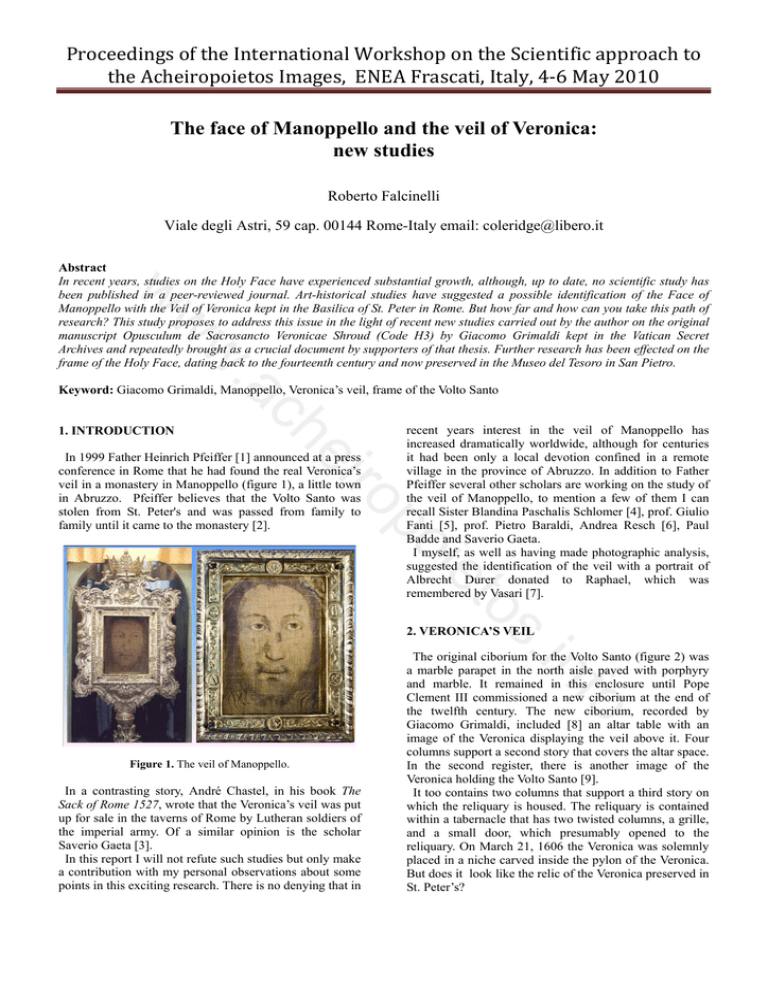
Proceedings of the International Workshop on the Scientific approach to the Acheiropoietos Images, ENEA Frascati, Italy, 4‐6 May 2010 The face of Manoppello and the veil of Veronica:
new studies
Roberto Falcinelli
Viale degli Astri, 59 cap. 00144 Rome-Italy email: [email protected]
ro
ei
ch
.a
w
w
w
Abstract
In recent years, studies on the Holy Face have experienced substantial growth, although, up to date, no scientific study has
been published in a peer-reviewed journal. Art-historical studies have suggested a possible identification of the Face of
Manoppello with the Veil of Veronica kept in the Basilica of St. Peter in Rome. But how far and how can you take this path of
research? This study proposes to address this issue in the light of recent new studies carried out by the author on the original
manuscript Opusculum de Sacrosancto Veronicae Shroud (Code H3) by Giacomo Grimaldi kept in the Vatican Secret
Archives and repeatedly brought as a crucial document by supporters of that thesis. Further research has been effected on the
frame of the Holy Face, dating back to the fourteenth century and now preserved in the Museo del Tesoro in San Pietro.
Keyword: Giacomo Grimaldi, Manoppello, Veronica’s veil, frame of the Volto Santo
1. INTRODUCTION
os
t
ie
po
In 1999 Father Heinrich Pfeiffer [1] announced at a press
conference in Rome that he had found the real Veronica’s
veil in a monastery in Manoppello (figure 1), a little town
in Abruzzo. Pfeiffer believes that the Volto Santo was
stolen from St. Peter's and was passed from family to
family until it came to the monastery [2].
recent years interest in the veil of Manoppello has
increased dramatically worldwide, although for centuries
it had been only a local devotion confined in a remote
village in the province of Abruzzo. In addition to Father
Pfeiffer several other scholars are working on the study of
the veil of Manoppello, to mention a few of them I can
recall Sister Blandina Paschalis Schlomer [4], prof. Giulio
Fanti [5], prof. Pietro Baraldi, Andrea Resch [6], Paul
Badde and Saverio Gaeta.
I myself, as well as having made photographic analysis,
suggested the identification of the veil with a portrait of
Albrecht Durer donated to Raphael, which was
remembered by Vasari [7].
2. VERONICA’S VEIL
.in
fo
The original ciborium for the Volto Santo (figure 2) was
a marble parapet in the north aisle paved with porphyry
and marble. It remained in this enclosure until Pope
Clement III commissioned a new ciborium at the end of
the twelfth century. The new ciborium, recorded by
Giacomo Grimaldi, included [8] an altar table with an
image of the Veronica displaying the veil above it. Four
columns support a second story that covers the altar space.
In the second register, there is another image of the
Veronica holding the Volto Santo [9].
It too contains two columns that support a third story on
which the reliquary is housed. The reliquary is contained
within a tabernacle that has two twisted columns, a grille,
and a small door, which presumably opened to the
reliquary. On March 21, 1606 the Veronica was solemnly
placed in a niche carved inside the pylon of the Veronica.
But does it look like the relic of the Veronica preserved in
St. Peter’s?
Figure 1. The veil of Manoppello.
In a contrasting story, André Chastel, in his book The
Sack of Rome 1527, wrote that the Veronica’s veil was put
up for sale in the taverns of Rome by Lutheran soldiers of
the imperial army. Of a similar opinion is the scholar
Saverio Gaeta [3].
In this report I will not refute such studies but only make
a contribution with my personal observations about some
points in this exciting research. There is no denying that in
Proceedings of the International Workshop on the Scientific approach to the Acheiropoietos Images, ENEA Frascati, Italy, 4‐6 May 2010 Journalists Paul Badde [10] and Saverio Gaeta [11], who
like me have had the opportunity to see it, tell in their
publications about their encounter with the Roman
Veronica [12], but they radically put into question its
authenticity, describing it as a decaying object, an image
"in ruins", which is sometimes impossible to identify [13].
see anything at all…”. It is known that nobody has ever
been allowed to take photographs closely. Unexpectedly,
however, a photograph (figure 4) of the relic has recently
appeared on the website of the Holy Face of Manoppello
[15]. Although technically bad (this is obviously a picture
taken without permission) it confirms the current state of
the relic.
ro
ei
ch
.a
w
w
w
Figure 2. The ancient cyborium of the Veronica.
I can confirm that strongly, as in October 2005 I had a
special permit to be able to closely observe it from the
gallery where it is kept in St. Peter's [14]. The two authors
above claim that we are faced with a false history. (figure
3).
Figure 4. Detail of the Veronica’s veil.
3. GIACOMO GRIMALDI AND THE CODE H3
fo
.in
os
t
ie
po
Some scholars like Saverio Gaeta have suggested that
the Veronica was stolen during the sack of Rome in 1527.
To support the theory of theft they propose that, since the
type of representation of the Veronica changed from
approximately that time, the original was stolen and
replaced with a fake that shows a completely different
iconography.
Saverio Gaeta has tried to emphasize this issue by
proposing an intuition about a work of 1618 by Giacomo
Grimaldi Opusculum de sacrosancto sudario Veronicae.
(figures 5 and 6).
Figure 3. Veronica’s veil exhibition in St. Peter in Rome.
The description of the scholar De Waal, now from the
last century, is revealing: “The beard is divided into three
points ... and it is dark brown, the same color, for a length
of about two fingers, can be found on the forehead;
supposing it is hair, it is not possible to see or distinguish
its pattern …of the eyes, the nose, the mouth…you cannot
Figure 5. The unpublished book of Giacomo Grimaldi.
Proceedings of the International Workshop on the Scientific approach to the Acheiropoietos Images, ENEA Frascati, Italy, 4‐6 May 2010 3. Note that the date of completion of the manuscript is
written in Roman numerals, but not fully and that the
calligraphy shows no remorse whatsoever. It is,
moreover, questionable the observation of Gaeta that
the title is drawn with formal care.
ro
ei
ch
.a
w
w
w
Figure 6. Cover of Grimaldi’s book dated 1618.
fo
.in
os
2. The date of the manuscript is clearly stated by
Grimaldi on page 158 stating:
“Finit liber. Laus Deo, e Deiparae Virgini. Ego
Jacobus Grimaldus manu propria scripsi e
subscripsi atque faciebam Romae in Civitate
Leoniana; idem manu propria Anno Domini
Millesimo Sexcentesimo decimo octavo, die tertia
Maiy in praeclara salutiferis Crucis inventione;
Paulo Quinto Pont. Max regnante feliciter”.
There are a number of designs that do not fall into
double lines demarcating the page (figures 8, 9). It seems
clear that these lines have been drawn after penned letters
and drawings. The case however is not isolated.
On the frontispiece of the 1620 manuscript copy
preserved in Florence it is clear that the writing of the
date, even if this is penned in full, lacks lines of
demarcation.
It is sure that the date of the work of Grimaldi was not
counterfeited. How would it be possible to describe an
operation taking place in 1617 in 1616? (figure 10).
I think that all scholars who hold this view have not
bothered to study directly the original Giacomo Grimaldi,
but instead have followed a line of research that is not
documented or worse, not verified.
t
ie
po
He states that the date of 1618 present in the title was
replaced with that of 1616 because it had to give the
impression that, following the request for a copy of the
relic by the Queen Constance of Austria, wife of the
Polish king Sigismund III, everything was regular and that
the original Veronica was still there. Without going into
historical details here, the hypothesis proposed by Gaeta
is rather curious.
Examining the original code H3 [16] preserved in the
Vatican Library I could easily see the following: (figure
7).
1. The frame appears on the title of Veronica, prior to
that of 1675, which had a plaque at the bottom where
it was written that Peter Strozzi said frame restored
in 1617. This restoration is described on page 108 of
the manuscript: “Instauratum cura Petri Strozae
canonici anno d.ni 1617 Orate Deum pro eo”.
Figure 7. Dating of Grimaldi’s book.
Figure 8. Edition of Florence.
Proceedings of the International Workshop on the Scientific approach to the Acheiropoietos Images, ENEA Frascati, Italy, 4‐6 May 2010 w
w
Figure 9. Graphic imperfections.
Figure 11. Detail of coat of arms.
ro
ei
ch
.a
w
Figure 10. Table of contents.
fo
.in
In the frontespice of Grimaldi’s volume of 1618,
Veronica’s veil is represented whithin a frame that he
considers very ancient. The occasion was its restoration
carried out by the canon Pietro Strozzi. Could it be the
13th century frame used again, adding an outer clothing
with crescents? (See figures 11, 12). This particular
decoration with crescents at the sides was interpreted by
some scholars as belonging to the coat of arms of the
Piccolomini family.
Instead I think I can state with certainty that this
symbology belongs to the family Strozzi, whose coat of
arms shows this graphics.
The present frame (pictures 13, 14) was made by the
goldsmith Carlo Spagna by request of Cardinal Francesco
Barberini and dates back to 1675 [17].
Let’s start examining if the measurements of the 16th
century frame, reported by Badde and Gaeta, as well as by
De Waal, have been taken precisely. Badde writes he has
been able to measure the relic: cm 32 x cm 20 inside the
golden frame, while the “face” alone is cm 28.5 long.
os
4. THE 1675 FRAME
t
ie
po
Figure 12. Comparison with 1350 frame and the 1635
edition of Grimaldi’s book.
Figure 13. Front of 1675 frame.
My personal measurements of the frame are: 34.4 x 23.3
for the gold leaf and 29.7 x 19 for the face area. Badde’s
figures would seem therefore unreliable.
Proceedings of the International Workshop on the Scientific approach to the Acheiropoietos Images, ENEA Frascati, Italy, 4‐6 May 2010 same Archive, adorned with a frame of fine silver and
images engraved all around, split into two parts probably
because of the carelessness of its attendants” [19]. In
conclusion it seems obvious that Grimaldi is speaking of
one crystal, (figure 17) but he doesn’t say if originally the
frame had crystal on both sides.
ro
ei
ch
.a
w
w
w
Figure 15. Analysis of the frame.
Figure 14. Back of 1675 frame.
fo
.in
In November 2007 I got a special authorization to study
at close range the 13th century frame (figure 15) kept in
the museum of the Treasury in the Vatican Basilica. Also
Paul Badde took some measurements. According to him
the frame is cm 25 × 25 in the area we are interested in.
It is necessary to stress that these measures were taken
by Badde empirically from outside the museum glass case
and not directly on the frame.
Even in this case I think his figures are wrong. I could
observe and measure the frame (figure 16) outside the
glass case and it measures 40 × 38 in the outer part and
31.7 × 29.5 inside.
Something doesn’t correspond. Another important point to
analyze is whether the frame had crystal on both sides to
favour the veil transparency, as many scholars have taken
for granted. We can quote Grimaldi: “A beautiful plate of
pure white and transparent rock crystal, still kept in the
os
5. THE 1350 FRAME
t
ie
po
De Waal says: “ A modern silver frame with the emblem
of Gregory XVI, cm 63 high and cm 51 wide, keeps under
a glass an ancient plate of golden metal, on which there is
a very fine net of silver thread. The golden plate is
surrounded by some small decorations…In this plate the
space for the Holy Face was cut. The plate is cm 31 high
and cm 20 wide; the Holy Face appearing below is high,
from the end of the beard cm 25 and cm 16 wide; his ears
and maybe a part of the face and hair are covered by the
plate…so that only cm 21 × cm 12 of the face are
visible...” [18].
Figure 16. The author analyzes the frame.
6. VERONICA’S VEIL COPIES
Between 1616 and 1617 Pietro Strozzi painted at least
four or five copies of the Veronica. Besides the one for the
Vatican vestry and the one for the Queen of Poland, the
others were destined to the Pope, the grand duke of
Tuscany and the bishop Roberto Ubaldini di
Montepulciano.
Proceedings of the International Workshop on the Scientific approach to the Acheiropoietos Images, ENEA Frascati, Italy, 4‐6 May 2010 Sforza in 1621. Finally the copy kept in Venetico in Sicily
(figure 22) dates back to the time of di Urbano VIII.
It seemed that other copies have not been available until
recently. During archival research, I was able to find a
copy of the Strozzi Veronica from 1617 in Bologna, in the
church of St. Jerome, known as the Certosa [20].
ro
ei
ch
.a
w
w
w
Figure 17. Damaged glass.
t
ie
po
On 7th September 1616 a peremptory letter was written
on behalf of Pope Paolo V, who forbid any new copy
under penalty of excommunication.
In the first months of 1628 the new Pope Urbano VIII
gave even severer provisions, as documented by two
circular letters sent to all archbishops by cardinal
Bernardino Spada on behalf of the Pope, where all faithful
were ordered to hand in any copy representing “ the real
sacred Image of the Holy Face” under penalty of
excommunication (figure 18).
Figure 19. Copy of Wien.
An important copy of the Veronica is kept in the
Schatzkammer in the Hofburg Palace in Vienna (picture
19). It dates back to 1617 and belonged to the family
Savelli until 1720, when Caterina Savelli gave it to the
Emperor Charles VI.
Another copy dating back to 1617 has been found in
Chiusa Sclafani, (figure 20) a small centre near Palermo
in Italy. Pope Clemente VIII gave it to a Franciscan friar,
Innocenzo, who was his personal counselor in Rome.
The copy kept in the Chiesa del Gesù in Rome (figure
21) was donated by the Pope Gregorio XV to the Duchess
fo
.in
os
Figure 18. Copies of the Veronica’s veil.
Figure 20. Copy of Chiusa Sclafani.
Proceedings of the International Workshop on the Scientific approach to the Acheiropoietos Images, ENEA Frascati, Italy, 4‐6 May 2010 The image is in all respects equal to the copy of Vienna.
We find, in addition to engraving on gold plate, even the
exact same frame (figures 25, 26) and the same engraving
by Pietro Strozzi. This copy [21], which was not known
to exist, was donated by Pope Paul V to Apollonia Maria
of Savoy [22] who in turn gave it to the Capuchin convent
in Bologna in 1647 (figure 27).
ro
ei
ch
.a
w
w
w
Figure 21. Copy of Chiesa del Gesù in Rome.
t
ie
po
Figure 23. New discovery: the copy of Bologna.
fo
.in
os
Figure 22. Copy of Venetico.
Currently it has not been exposed to the public for
several years and perhaps for this reason it has not been
reported (figure 23). I state that I am gathering more
historical references as the discovery is very recent.
In the back of the complicated outer frame there is a
scroll that describes briefly the origin (figure 24).
Figure 24. Scroll in the back of the frame.
Proceedings of the International Workshop on the Scientific approach to the Acheiropoietos Images, ENEA Frascati, Italy, 4‐6 May 2010 w
w
Rome, is still the original or has been replaced in an
unspecified date unknown to us. My careful study of the
code H3 of Giacomo Grimaldi, who is still unpublished,
allowed me to shed light to determine the exact date of the
manuscript. The direct study of the two frames of the relic
has clarified many doubts and uncertainties. The error in
dating the manuscript by some scholars shows that the
documents should always be studied directly, especially if
unpublished. I think that the exploratory path on history
and iconography of Veronica’s veil will be in future still
full of surprises. I left open the various hypotheses
proposed relying on a clear comparison with the other
scholars involved.
Figure 25. Wien and Bologna: the same frame.
REFERENCES
Figure 26. Detail of the inscriptions of Strozzi.
fo
.in
os
t
ie
po
ro
ei
ch
.a
w
1. For the remarkable existing bibliography of this author
see: Pfeiffer, H., Una visita a Manoppello, in
Collegamento Pro Sindone, 1986 Marzo/Aprile, p. 21-34;
La Sindone di Torino e il Volto di Cristo nell'arte
paleocristiana, bizantina e medievale occidentale,
Emmaus 2, Roma 1982; Il Volto Santo di Manoppello,
Carsa Edizioni, 2000; Implicazioni teologiche delle
immagini reliquie.La Sindone di Torino e il Velo di
Manoppello. atti del 3° Congresso Internazionale, 30–31
Ottobre 1999, Editrice Velar, Gorle (BG) (1999); L’arte
degli Anni Santi. Roma 1300-1875, a cura di Fagiolo, M. e
Madonna, M.L., catalogo della mostra, Milano 1984, pp.
106-126; La storia delle Acheropite, da “Il Volto Santo di
Manoppello”, anno 87, n.1; Il Velo di Manoppello, la
Sindone e l’immagine autentica di Cristo nell’arte:saggio
di identificazione e di distinzione, in AA.VV.,
Identification scientifique de l'homme du Linceul: Jésu de
Nazareth, Symposium de Rome 1993, O.E.I.L - F. X. de
Guibert, Paris 1995.pp.81-84; La Veronica Romana e suoi
riflessi nell’arte, in “Il Volto dei Volti”, atti del 1°
Congresso Internazionale, 12-13 Ottobre 1997, Editrice
Velar, Gorle (BG) 1997; Ragioni storiche, teologiche e
politiche per la tradizione del volto di Gesù nei secoli, in
“Il Volto dei Volti”, atti del 2° Congresso Internazionale,
24-25-26 Ottobre 1998, Editrice Velar, Gorle (BG) 1998.
2. Fr Heinrich Pfeiffer:” Is becoming more consistent the
hypothesis that the Veil was stolen at the time of Pope
Paul V and brought to Manoppello. If the soldier held
prisoner in Chieti, husband of the woman who sold the
Velo with the figure of Christ in 1618 to Dr. De Fabritiis,
is the same thief who stole the sacred relic in Rome, it is
not established.”
Figure 27. Mary Apollonia of Savoy.
7. CONCLUSION
In this research I attempted to clarify whether the current
veil of Veronica, preserved in the basilica of S. Peter's in
3. Gaeta, S., Sparì la "Veronica" durante il Sacco di
Roma? Relazione Convegno "Il Volto Santo di
Manoppello
e
l'iconografia
dell'immagine
di
Cristo"Venerdì 10 - Sabato 11 febbraio 2006 Aula Magna
del Rettorato - Università "G. d'Annunzio" Chieti.
4. Paschalis Schlömer, B., La relique inconnue, in
Identification scientifique de l'homme du Linceul: Jésus
Proceedings of the International Workshop on the Scientific approach to the Acheiropoietos Images, ENEA Frascati, Italy, 4‐6 May 2010 de Nazareth, Symposium de Rome 1993, O.E.I.L - F. X.
de Guibert, Paris 1995.pp.73-79; Der Schleier von
Manoppello und das Grabtuch von Turin,Resch Verlag,
Innsbruch 1999 e 2001; La bellezza del volto di Gesù, atti
del 5° Congresso Internazionale, 20–21 Ottobre 2001,
Editrice Velar, Gorle (BG) (2001); Le sindon et la
Veronique, in Acheiropoietos\“Non fait de main d’homme,
Actes du IIIeme Symposium Scientifique International du
CIELT, Nice 12-13 maj1997, Edition du CIELT (1998).
pp. 151-164.
w
w
5. Fanti, G., Relazione tecnica sulle indagini eseguite in
data 15-16 aprile 2001 sul Volto Santo di Manoppello,
Archivio Santuario del Volto Santo.
6. Resch, A., Das Antlitz Christi, Resch Verlag, Innsbruck
(2005).
13. “Es ist ein Objekt in Auflösung: ein fleckiger dunkler
Stoff ohne jede Kontur ... Ich tastet mit dem Strahl meiner
Stablampe das Gewebe ab: doch es ist kaum
auszumachen, daß es überhaupt Gewebe ist. Das Bild ist
eine Ruine”, in: Badde, P., Das Muschelseidentuch, cit.,
pag. 259
14. I was also allowed by the Sanctuary’s rector to
observe the Holy Face through a portable microscope, for
a more detailed approach.
ro
ei
ch
.a
w
7. Falcinelli, R., Il Volto Santo di Manoppello: è
Raffaello?, dossier in Hera, num. 68, september 2005 with
bibliography.
12. Fundamental the works of Wolf, G., 'Or fu sì fatta la
sembianza vostra?' Sguardi alla Veronica e alle sue copie
artistiche, in Il Volto di Cristo, a cura di Giovanni
Morello e Gerhard Wolf, Electa, Milano 2000 , pp. 103114; Schleier und Spiegel: Traditionen des Christusbildes
und die Bildkonzepte der Renassance, Wilhelm Fink,
Munchen 2002 (amazing work). See also: Belting, H.,
Bild und Kult: eine Geschichte des Bildes vor dem
Zeitalter der Kunst, Beck, Munchen 1990.
8. Grimaldi, G., Liber de sacrosancto sudario Veronicae
salvatoris nostri Gesu Christi ac lancea quae latus eius
aperueit in Vaticana Basilica maxima veneratione
asservatis, 1618 Cod. H3. See also: Niggl, R., Giacomo
Grimaldi 1568-1623, inaugural dissertation, Munchen
1971, Muntz, E., Ricerche intorno ai lavori archeologici
di Giacomo Grimaldi, Rivista Europea, Firenze (1881).
17. See: Montagu J., The frame of the Volto santo, in
Bollettino Monumenti, Musei e Gallerie Pontificie, XIII,
Città del Vaticano, 1993, pp.39-48.
18. De Waal, A., Gli antichi tesori sacri della Basilica
Vaticana, in Dissertazioni della Pontificia Accademia
Romana di Archeologia, Roma 1894. The translation is
mine.
19. Grimaldi, G., Liber de sacrosancto sudario Veronicae,
cit., fol. 53 recto.
20. A warm thanks for helping me to Father Mario
Micucci, Prior of the Chiesa Monumentale San Girolamo
della Certosa di Bologna.
.in
21. n° catalogo E 2877 Avanti: lamina dorata: 19,5 x
29,8.Cornice con madreperla: 30,7 x 41.Cornice dorata
teca: 31,5 x 42,4 (all’interno). Cornice dorata teca: 35,6 x
47,1 (all’esterno). Retro: solo tavoletta: 35 x 38,2. Con
striscia tavola superiore e striscia tavola inferiore: 35 x 50.
Quadro complessivo con fregi: 74 x 89.
fo
11. Gaeta, S., L’enigma del volto di Gesù,Rizzoli, Milano
2010.
16. A very special thanks to Mons. Dario Rezza, dott.
Mirko Stocchi and dott. Vincenzo Piacquadio for helping
me in Archivio Capitolo di San Pietro.
os
10. Badde, P., Das Muschelseidentuch, Ullstein, Berlino
2005, id., La seconda Sindone, Newton Compton Editori,
Roma 2007.
Picture, in all probability, taken by Mr. Raymond Frost.
t
ie
po
9. For a serious approach to this wide research field is
still remains fundamental today the study of Dobschütz,
E.v., Christusbilder, Untersuchungen zur christlichen
Legende, Leipzig 1899. See also: Gaffre, R.P., Les
portraits du Christ; etude d'iconographie religieuse,
Paris, Imprimerie des Orphelins-Apprentis d'Auteul,1903;
Millet, G., Recherches sur l’iconographie de l’E’vangile
aux XIV, XV et XVI siècles, 1916, Pfeiffer, H., La Sindone
di Torino e il Volto di Cristo nell'arte paleocristiana,
bizantina e medievale occidentale, Emmaus 2, Roma
1982; Bulst, W. - Pfeiffer H., Das Turiner Grabtuch und
das Christusbild. Das Echte Christusbild, Knecht,
Frankfurt am Main 1991; Wilson, I., Holy Faces, Secret
Places, Doubleday & Co., New York, 1991; AA. VV.,
The Holy Face and the Paradox of Representation, Papers
from a Colloquium held at the Bibliotheca Hertziana,
Rome and the Villa Spelman, Florence, 1998, Nuova Alfa
Editoriale, Bologna 1998; Coppini, L., Cavazzuti, F., Le
icone di Cristo e la Sindone, Edizioni San Paolo, 2000;
AA.VV., Il Volto di Cristo, Electa, Milano 2000.
15. http://holyfaceofmanoppello.blogspot.com/
22. Daughter of Duke of Piemonte Carlo Emanuele I of
Savoia (Rivoli, 1562 - Savigliano, 1630) and of Caterina
d’Asburgo (1567-1597) daughter of the king Filippo II di
Spagna, Maria Francesca Apollonia was born in Turin in
1594 and dead in 1656.



